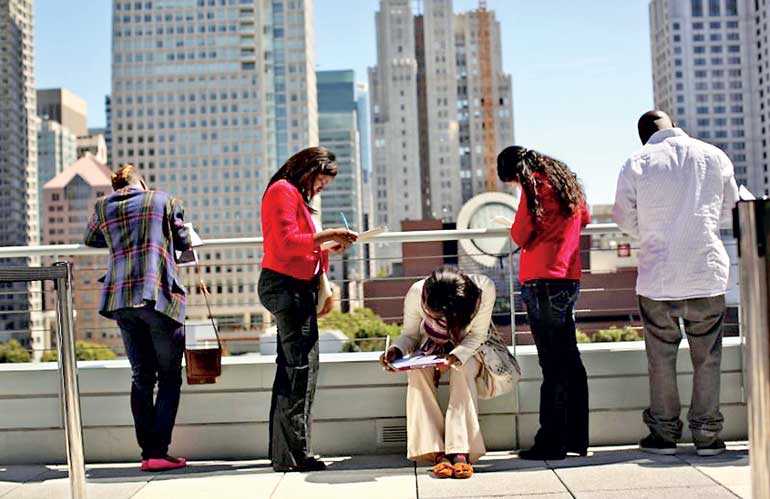Tuesday Dec 02, 2025
Tuesday Dec 02, 2025
Tuesday, 1 May 2018 00:00 - - {{hitsCtrl.values.hits}}

WASHINGTON (Reuters): The US economy slowed in the first quarter as consumer spending grew at its weakest pace in nearly five years, but a surge in wages amid tightening labour market conditions and lower tax rates suggested the setback is likely temporary.
Gross domestic product increased at a 2.3% annual rate, the Commerce Department said in its snapshot of first-quarter GDP on Friday, also restrained by a moderation in business spending on equipment and investment in homebuilding.
These factors were partially offset by a rise in inventories and a narrowing of the trade deficit. The economy grew at a 2.9% rate in the fourth quarter. Domestic demand increased at a 1.7% rate, the slowest in two years, after rising at a brisk 4.8% pace in the final three months of 2017.
The moderate first-quarter growth is, however, probably not a true reflection of the economy’s health as GDP tends to be sluggish at the start of the year because of a seasonal quirk.
Economists expect growth will accelerate in the second quarter as more households feel the impact of the Trump administration’s $1.5 trillion income tax package on their paychecks. The tax cuts came into effect in January.
Lower corporate and individual tax rates as well as increased government spending will likely lift annual economic growth close to the administration’s 3% target. Economists polled by Reuters had forecast output rising at a 2.0% rate in the January-March period.
“Tax cuts and government spending increases should lead to better overall economic activity,” said Joel Naroff, chief economist at Naroff Economic Advisors in Holland, Pennsylvania.
Federal Reserve officials are likely to shrug off the first-quarter performance. The US central bank raised interest rates last month in a nod to the strong labour market and economy, and forecast at least two more rate hikes this year. Minutes of the March 20-21 meeting published earlier this month showed policymakers “expected that the first-quarter softness would be transitory,” citing “residual seasonality in the data, and more generally to strong economic fundamentals.”
But a jump in wage growth and an acceleration in inflation in the first quarter will attract attention when Fed officials meet next Tuesday and Wednesday. In a separate report in Friday, the Labor Department said wages and salaries shot up 0.9% in the first quarter. That was the largest increase since the first quarter of 2007 and followed a 0.5% rise in the fourth quarter. Wages and salaries were up 2.7% in the 12 months through March compared to 2.5% in the year to December. The GDP report showed the Fed’s preferred inflation gauge, the personal consumption expenditures (PCE) price index excluding food and energy, increased at a 2.5% rate - the fastest pace since the fourth quarter of 2007. The core PCE price index rose at a 1.9% pace in the fourth quarter.
The US central bank has a 2% inflation target.
“It is increasingly difficult to argue that the 2% inflation target hasn’t already been breached,” said Steven Blitz, chief US economist at TS Lombard in New York. “Could the Fed go next week? Not likely, but there are no rules preventing it. A more hawkish statement is coming.”
The dollar initially rose against a basket of currencies after the data, but gave up gains to trade little changed. Prices for US Treasuries were marginally higher while stocks on Wall Street fell.
Growth in consumer spending, which accounts for more than two-thirds of US economic activity, braked to a 1.1% rate in the first quarter. That was the slowest pace since the second quarter of 2013 and followed the fourth quarter’s robust 4.0% growth rate. Consumer spending in the last quarter was undercut by a decline in purchases of motor vehicles, clothing and footwear as well as a slowdown in food and beverages outlays. This likely reflects delayed tax refunds. In addition, surveys suggested many workers did not see the tax cut boost to their paychecks until late in the quarter.
Income at the disposal of households increased at a 3.4% rate in the first quarter, accelerating from the fourth quarter’s 1.1% pace. Households also boosted savings, which bodes well for a pickup in spending. Business spending on equipment slowed to a 4.7% rate in the January-March quarter after double-digit growth in the second half of 2017. The cooling in equipment investment comes as the stimulus from a recovery in commodity prices is fading. Investment in homebuilding was unchanged in the first three months of the year as sluggish home sales caused by a dearth of houses on the market weighed on brokers’ commissions. Residential investment increased at a 12.8% rate in the October-December period. Government spending grew at a 1.2% rate, slowing from the fourth quarter’s 3.0% pace. Spending is expected to accelerate in the second quarter after the US Congress recently approved more government spending.
Trade added 0.20 percentage point to GDP growth as weak a US dollar and strengthening global economy bolstered exports.
With consumer spending slowing, inventories increased at a $33.1 billion rate in the first quarter, up from a $15.6 billion pace in the prior period. Inventory investment contributed 0.43 percentage point to GDP growth after subtracting 0.53%age point in the fourth quarter.